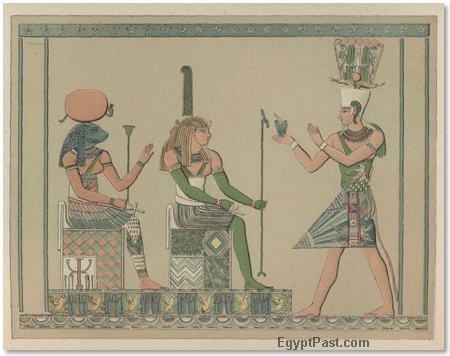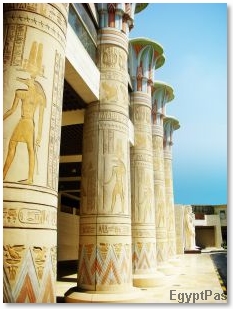Egyptian History - Part 2

An Egyptian Vignette
During this period and the following changes occurred; art lost its primitive simplicity and freshness, taking on a stereotyped form, which was an object of imitation in later times. Under the last king of the fifth dynasty, Unas (Manetho, OBNOS, q. v.), the practice of inscribing the chambers of the pyramids began, which was continued under the sixth dynasty by Teta (Othoes, of Manetho), Pepi I. (Phios), and Pepi II. (Phiops).
Toward the end of the reign of Pepi I., third king of the sixth dynasty, a most notable ruler, whose monuments extend from Tanis to Denderah, a decentralization seems to have begun. Memphis was no longer the necropolis of the whole land, but Abydos, where myth located the grave of Osiris, sprang into prominence never to be displaced. Many other resting-places for the dead were also sought out. Nearly all that is known of this period and that of the following two kings is derived from a long inscription of Una, a contemporary noble already mentioned. Pepi II., the fifth king, waged war with the Beduin (see above) and defended the mines of Sinai, which had been previously worked. Queen NITOCRIS (q. v.) closed the dynasty.

Beautifully Carved Temple Pillars
Thence till the eleventh dynasty there is a long period of darkness; but the interval seems to have been filled up with the gradual development of the power of the nomarchs, till finally in the eleventh Thebes stood forth in the lead. In this period the ancient religion and writing underwent change, for in the twelfth dynasty many new forms appear. Thebes became the chief city, and maintained its position for ages. It was from Thebes also that the later opposition came which ended in the expulsion of the Hyksos after the next dark period in the history. In each case the country must have gone through troublous times, and while the names of many kings are known, they are incapable of chronological arrangement. The eleventh dynasty, however, was a period of renaissance, though it was rude compared with what preceded.
Changes are seen in the steles and in the sarcophagi, while the hieroglyphs are clumsy. The princes of the time were obscure, but the power of rulers was growing, and in the following dynasty (twelfth) it was fully exerted under the USERTASENS (q. v.) and Amenemhas, so that, from being limited to the Thebaid, these kings reached out to Ethiopia and Syria, acquiring the former by conquest, while trade opened friendly relations with the East. The state was reorganized and placed on a firmer footing and in wider relations than ever before.
pyramids Egypt Mummies Search Engines Link Report
Egyptian Cities | Egyptian Education | Ancient Egypt | egyptian clothing | Egyptian Houses | The Egyptians | Egyptian Family Life | Egypt and its Neighbours | Government in Ancient Egypt | Egyptian History | Military | Organization of Ancient Egypt | Recreation | Egyptian Religion | Pyramids | About | Privacy Policy | Site News | Site Map
EgyptPast.com - Facts and Information About the History of Ancient Egypt
-